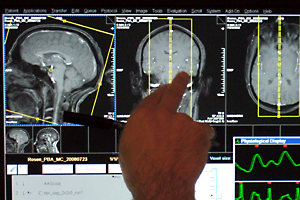Being a neurologist in the era of fMRI scanners must feel like being a kid in a candy shop. What's going in there while we're, say, shopping? How about reading? Watching campaign ads? Now that we have a way to take real-time images of the brain at work, the scientific possibilities are endless.
On the surface, the experiment at the heart of this story might seem pretty narrow. It focuses on a rare disorder called pseudobulbar affect, which afflicts only people with ALS, or Lou Gehrig's disease -- a far cry from the universal rites of shopping or reading. But what’s fascinating about pseudobulbar is the light it might shed on all of us, and one of the most primal and mysterious human experiences of all: emotion.
People with pseudobulbar get happy and sad, just like the rest of us. They laugh and cry like the rest of us too. But then sometimes, something else happens: They keep going. And going. In this video, you can see how what looks like a laughing fit morphs into something else entirely. It’s as if the laughing and crying mechanisms have become detached from whatever part of the brain triggered the emotion in the first place. Maybe – and this is the hope of scientists Howard Rosen and Robert Levenson – by seeing that disconnect take place in real time through the fMRI, we’ll understand, for the first time, how emotion plays out in people without pseudobulbar affect.
(And it doesn’t stop there. Listen to the radio piece to hear Rosen's theory about what PBA might mean for depression, obsessive compulsive disorder, and, particularly, PTSD.)

